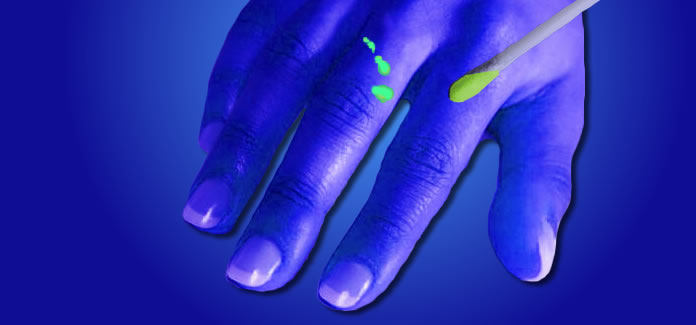After a rape, forensic nurses fully document sexual assault victims’ injuries by using a dye that causes lacerations and tears on the skin to “light up.” But the dye – a dark blue – doesn’t show on people of color, and that often means the perpetrators go free. A fluorescent dye may be the answer, posits University of Virginia researcher Kathryn Laughon, associate professor in the School of Nursing.
Laughon is now testing dyes that will illuminate tissue lacerations and abrasions for all skin types and colors.
Laughon, who is also an active forensic nurse examiner, explains that when women are examined after a suspected sexual assault, the nurse typically applies the dye, wipes the extra off, and areas of injury “light up.” Nurses like Laughon see two to three times as many injuries with the dye as without, so it’s a critical step in assessing what’s happened – and documenting it.
But for women of color, the contrasts don’t “light” in the same way. And if injuries don’t show, they’re not documented, and the perpetrators ultimately may never be prosecuted. Research has repeatedly found that black women who are raped are much less likely to move through the criminal justice system than their white peers, which may be due in large part to the way the dye works – or doesn’t work – on them.
“I don’t have a magic way to tell what happened,” says Laughon, “but at least all the victims are getting the same effectiveness from an exam. When we do find significant injuries, perpetrators are twice as likely to be charged, and then twice as likely to go to jail.”
Of the 17 million American women who have been raped, 85 percent of them are women of color (19 percent black, 7 percent Asian/Pacific Islander, 35 percent American Indian/Alaskan and 24 percent are mixed race), though women of color comprise just over a third of the female population (36.3 percent).Laughon’s research, in its early stages, is looking at already existing fluorescent dyes to see what best captures injuries on every skin type and color while not interfering with any subsequent DNA analyses. She also wants to be sure that the fluorescent dye isn’t painful or irritating.
From there, she plans to test the dye on women who’ve just had consensual sex (which produces microtears and injuries too) to see about the dye’s pick-up. This step will also help understand what injuries from consensual sex look like and compare them to injuries sustained by suspected rape victims. Of the candidate dyes being tested, Laughon is zeroing in on several already used in eye procedures that contain flourozene. A unique aspect of Laughon’s research is that it’s seeking funding in an innovative six-month pilot program launched this month by the University of Virginia. It’s U.Va.’s first foray into crowdfunding.
Laughon’s project, “Reducing Inequity in Forensic Exams Following Sexual Assault,” being done in collaboration with Shayn Peirce-Cottler in U.Va.’s Department of Biomedical Engineering and Cassandra Fraser in the Department of Chemistry, is seeking to raise $19,000.
“Raising a relatively small amount of research funding through crowdfunding would help us go a long way toward identifying a solution to this important problem,” Laughon says.
Media Contact
Article Information
June 19, 2013
/content/uva-s-laughon-testing-rape-kit-dye-will-work-all-skin-colors

